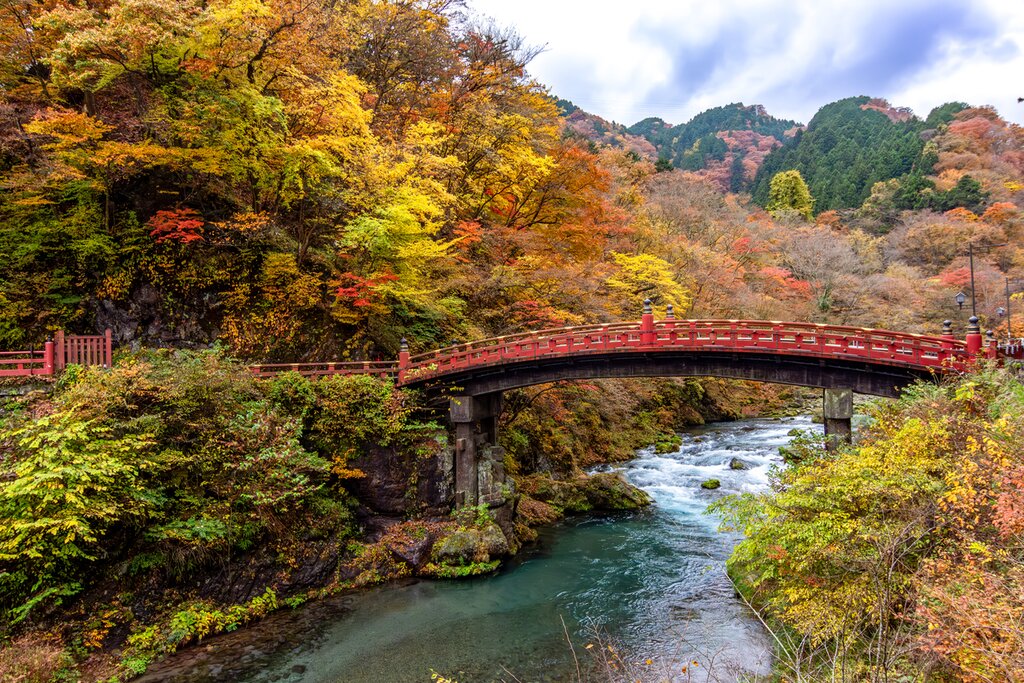Weather
Early September is still considered summer in Japan, whereas late September is autumn. Temperatures are quite high, but generally cooler than sweltering July and August. Average September highs in the major cities of Honshu and Kyushu (Tokyo, Kyoto, Osaka, Fukuoka) are around 81-84°F (27-29°C). Lows are around 70°F (20°C), so it stays pretty warm overnight. Farther north, Hokkaido is always cooler than the islands farther south, and September temperatures range from 57-72°F (14-22°C). Okinawa remains hot in September, with temperatures ranging from 77°F (25 °C) to 86°F (30°C).
Japan's rainy season is divided into two halves in much of the country (Honshu, Kyushu, and Shikoku). The first batch of rain comes in June and then again in late August and early to mid-September. September's rains are distinct from the earlier ones, though, as there's a greater risk of typhoons, which are very heavy storms that can bring normal life to a brief standstill.
Typhoons can, and do, happen during other months too, though. If you do find yourself traveling in Japan during a major typhoon, just plan to stay at your accommodation for the duration. Bullet trains can be canceled when there are high winds. Typhoons and their effects usually pass within a couple of days, unless they're exceptionally strong and cause greater damage.
Crowds & Costs
September is a relatively quiet month on the tourism front in Japan, as schools are back, and there are no major national holidays. And while Japan sees a regular stream of foreign visitors throughout the year, September is a less popular month than later in the autumn, when temperatures and rainfall are considered better for sightseeing.
September is the shoulder season, so book accommodation and transport as far ahead of time as possible, but don't expect major crowds at popular spots (although many parts of Japan are always somewhat crowded).
Where to Go
Later in the month, the Fuji area is a great destination with the skies clearing of the haze and humidity that hangs over the country throughout summer. The iconic mountain is attractive at any time of year, but you wouldn't always know it's there when the weather's hazy. The Fuji climbing season ends in mid-September, but you don't have to have ambitions to climb the volcano to enjoy the area. The Fuji-go-ko (Fuji Five Lakes) and Hakone areas offer views, outdoor attractions like hikes and boat rides, volcanic attractions, and some of Japan's most popular theme parks if you're traveling with kids.
The must-see classics of Tokyo and Kyoto—and if you have a bit more time, Nikko, Nara, and Hiroshima—are also good places to visit at this time of year. If the weather turns wet, there are plenty of indoor things to do in these cities, but when conditions are good, the outdoor parks, temples, shrines, and general neighborhoods will be pleasant to walk around. Nikko is at a higher altitude, so it's often cooler than nearby Tokyo, and there are beautiful outdoor attractions here, too, such as the Nikko National Park and Lake Chuzenji.
When typhoons are approaching, it's best to avoid Okinawa, Kyushu, and Shikoku, as these areas are prone to strong winds and rain.
Chat with a local specialist who can help organize your trip.
What to Do
Although conditions in September aren't as good for climbing Fuji as in the previous month, early September is still the Fuji climbing season because snow usually doesn't return to the top until later. This isn't a rugged wilderness trek as the climb is extremely popular, but it's physically challenging, and the views are spectacular.
General sightseeing with a mix of indoor and outdoor activities is a good option for September. If you get unlucky with the weather, your trip won't be as affected as it would be if you plan to spend a lot of time outdoors. There are fantastic museums, galleries, restaurants, temples, and other indoor attractions in all major Japanese cities, as well as some minor ones.
Events in September
Kishiwada Danjiri Matsuri, Osaka. Most summer festivals are held in Japan in July and August, but Osaka's Kishiwada Danjiri Matsuri is a late-summer favorite. Large floats are pulled through the streets of Kishiwada, and there's a healthy dose of dancing, eating, and drinking.
Traveling to Japan in September? Check out these great itineraries
Hike Japan's Nakasendo Trail - 5 Days. Step back in time and immerse yourself in nature on this five-day hiking trip along the historic Nakasendo Trail. Feudal lords and samurai once walked this mountain path connecting Kyoto and Tokyo.
Japanese Cycling Adventure - 7 Days. The beautiful ancient city of Kyoto is the spiritual home of Japan and the perfect base for this weeklong cycling adventure. Explore the streets of Kyoto by bike and venture farther afield as you delve into Japanese culture and cuisine.
Explore Japan: Tokyo, Hakone & Kyoto - 7 Days. This weeklong trip packs in plenty of exploration, so you can discover a good amount of the country's culture and history in a short time.
More Helpful Information
Japan in August
Japan in October
Best Time of Year to Visit Japan
How Many Days to Spend in Japan
A note on diacritical and retroflex markings: In order to support the best technical experience and search functions, diacritical markings have been omitted from this article.
